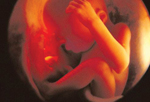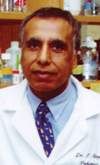|
by Cindy
Abole
Public Relations
Seven years ago when the doors
opened at the Charles P. Darby
Children's Research Institute, the
MUSC community celebrated the
science and medical knowledge
gained through the Department of
Pediatrics. They also were anxious
for new translational research
discoveries and the potential for
preventing and improving childhood
diseases.
When Lowcountry pediatrician and
then Department of Pediatrics
chairman Charles P. Darby Jr.,
M.D., founded the Children's
Hospital in 1987, he shared a
vision to improve children's
health care in South Carolina. An
important part of this vision
included a plan to enhance
research and discovery. To do
this, Darby and Children's
Hospital leadership focused on
recruiting talented physicians,
scientists and health care
professionals who could work
collaboratively under one
facility.
Before the institute existed,
pediatric research was more
dispersed between Children's
Hospital pediatric programs and
basic science departments
throughout the university.
Research was conducted in
pediatric cardiology,
endrocrinology,
hematology/oncology and
neonatology-perinatology and
developmental pediatrics.
Darby's vision still resonates
within the institute and across
campus. Today, more than 150
investigators and staff work in
high tech laboratory modules and
research programs within South
Carolina's largest, most
comprehensive pediatric research
facility. Investigators have
received National Institutes of
Health (NIH) translational funding
for basic and translational
research in areas including
cancer, blood disorders,
congenital heart disease, multiple
sclerosis, AIDS and immunological
diseases, genetic disorders,
diabetes, pulmonary disease,
learning disabilities and more.
The institute's scientific
director and pediatric
developmental neurogenetics
director Inderjit Singh, Ph.D., is
proud of the progress made by
Children's Hospital clinicians and
scientists in bridging the
translational gap on campus and
collaboration across the state.
"We've been successful in taking
basic science activities into
translational science and
conducting clinical research. Our
goal is to provide institutional
support for faculty-initiated
research, facilitate more
interactions between basic and
clinical scientists and build a
supportive infrastructure for
guiding clinical translational
research projects toward
preclinical and human
translational research trials."
 The Children's
Hospital has been involved in
many translational research
discoveries including the study
of neuroprotective agents in the
brains of preterm babies. The Children's
Hospital has been involved in
many translational research
discoveries including the study
of neuroprotective agents in the
brains of preterm babies.
According to Singh, pediatric
research collaborations on campus
continue to flourish. Discoveries
from research on childhood
diseases have already progressed
to clinical trials and beyond.
Some research studies are on track
for further development in the
production of new FDA-approved
drugs, therapies and clinical
interventions.
In 2011, Robert Gourdie, Ph.D., a
professor in cell biology and
regenerative medicine,
successfully received two patents
for the development and
commercialization of a
wound-healing, scar-reducing
peptide gel.
Gourdie's team developed this
product from studying electronic
signaling within heart muscles.
They found that the peptide gel
decreased scar tissue and healed
wounds faster in laboratory
animals. Their work led to
Gourdie's collaboration with First
String, a biotech developer. The
spin-off biotech company supports
regenerative medicine technology.
The gel has further uses for
spinal cord injury patients and
macular degeneration.
Translational scientist Bruce
Hollis, Ph.D., and neonatologist
Carol Wagner, M.D., have made
great progress in their studies
with vitamin D in human milk and
pregnancy.
In the last decade, Hollis and
Wagner have discovered how the
body produces vitamin D when it is
exposed to sunlight deficiency and
how it affects the body's cell
function and immunity. They
conducted two NIH-supported pilot
studies as well as large-scale
studies, incorporating 700
subjects each, and gave randomized
vitamin D supplements to pregnant
and lactating women. They
concluded that women, especially
during pregnancy, should take
4,000 IUs (international units) of
vitamin D daily to improve
pregnancy outcomes.
 Dr. Inderjit Singh Dr. Inderjit Singh
Singh's study of
adrenoleukodystrophy led to the
discovery of statin drugs for
patients with multiple sclerosis.
In other research, Singh, also
working with neonatologist Doe
Jenkins, M.D., studied the effects
of N-acetyl cysteine and its
protective properties in the
developing brain of unborn babies.
In clinical trials, Jenkins
administered medicine to mothers
with fevers prior to birth. Their
breakthrough work provided
preventative treatment for
cerebral palsy.
In addition, researchers and
clinicians also support scientific
and analytical work with MUSC's
Proteomics and Lipidomic centers.
Looking ahead, Singh hopes to
continue the team's research focus
on pediatric cancers, childhood
obesity, nutrition, inflammation
and genetic disorders.
According to Singh, with the
growing prevalence of Alzheimer's
disease and stroke in adults, he
would like to see more scientists
focus on understanding the factors
that cause these diseases in early
development.
Singh, Department of Pediatrics
Chairman Rita Ryan, M.D., and
Children's Hospital leadership are
in the process of recruiting the
institute's next executive
director. Pediatric leaders will
continue to make strategic new
recruitments of translational
scientists. Plans are being
developed to enhance fellowship
training and educational programs
to boost research productivity
across all disciplines.
|



 The Children's
Hospital has been involved in
many translational research
discoveries including the study
of neuroprotective agents in the
brains of preterm babies.
The Children's
Hospital has been involved in
many translational research
discoveries including the study
of neuroprotective agents in the
brains of preterm babies. Dr. Inderjit Singh
Dr. Inderjit Singh